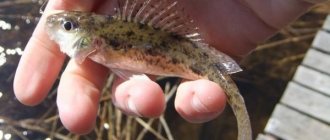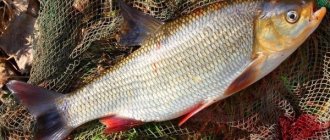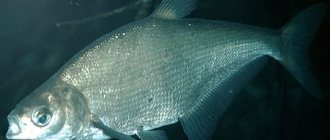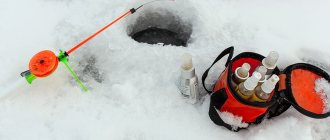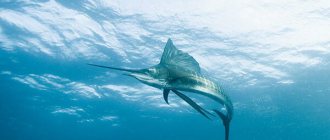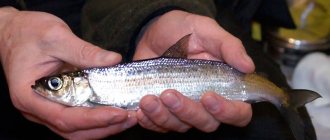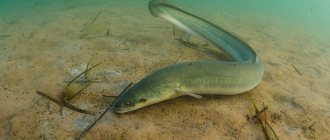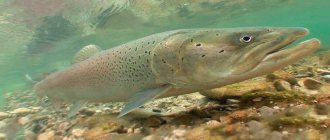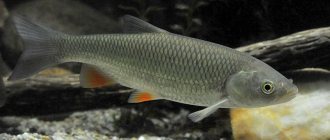Looking at the photograph of a loach, it is difficult to believe that it belongs to the representatives of cyprinids.
However, this freshwater fish, vividly reminiscent of an eel or snake, belongs to the order Cyprinidae, the class of ray-finned fish.
The loach has a telling name; this long fish can wriggle as well as a snake.
There are several reasons why fishermen do not like to catch loaches.
They are displeased by the appearance of the fish, its restless movements, and the squeaking noise it makes when in human hands.
In some regions, because of these sounds, the loach is called the squeak.
This is a small fish, the maximum length of which rarely reaches 35 cm. Its average size is 15-29 cm.
The body of the loach, covered with small, barely noticeable scales, has the shape of a cylinder.
There are individuals that have no scales at all.
The body of the loach is covered with a thick layer of mucus.
The head of the loach is small, extended forward, the eyes are small, round, yellow.
The gill openings are small, near the mouth, and there are up to a dozen antennae on the soft lips.
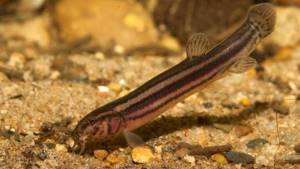
The fins of the loach are round in shape and decorated with small brown spots.
There is a kind of decoration along the sides of the fish - three dark stripes, the middle one is wider than the rest.
Small black specks are clearly visible on the back of the loach; the belly has a yellowish tint, it is always much lighter than the back.
The color of a loach depends on the quality of its habitat. Light-colored loaches are found in clean running water; in polluted water bodies their color becomes much darker.
Sometimes anglers manage to catch completely white fish, the so-called albino loach. But this happens very rarely.
Up
Description of the fish
The length of this fish is up to 30 cm, the average length is about 15-18 cm. The loach has small scales, but quite visible. The head is small, extended forward, the eyes are yellow, located on top. The body is long, similar to a snake. The fish is called a squeak because when caught it wriggles and squeaks. The tail of the loach is small and has a rounded shape.
There are antennae near the mouth, the number varies from 6 to 12 pieces. The nostrils are elongated and rounded. Males have a thick and long second ray of the pectoral fin, unlike females. Males also have a thickening on one and the other side, which is formed by adipose tissue. Loaches can live for about 10 years.
Varieties of loach
The loach family includes many species of fish, there are 177 of them. Let's look at the most common types of loaches:
| Type of loach | Description |
| Common spined loach | The smallest fish belonging to the loach family. They live in almost all of Europe, with the exception of some countries. Most often, this variety can be found in the CIS, Northern China, Japan, and Asia. The length of the fish does not exceed 10 cm. The color of the body is light yellow, and there are large spots on one and the other side. |
| Common loach | The location of such a loach is muddy reservoirs in Europe and Asia. The back has a brown color, where there are many dark spots. The length of the fish is 15 cm, sometimes up to 30 cm. The color depends on the location and living conditions; the majority of loaches have a brown back with a large number of dark spots, and the belly is yellow and also has many spots. In the center of the body there is a thick dark stripe, from which narrow stripes extend. |
| Amur loach | This fish can be found in northeast Asia, Siberia, Sakhalin, Japan and China. One of the largest fish of the loach family, reaching 25 cm or more. And those fish that live in the aquarium, their length does not exceed 18 cm. The color of the fish is yellow-copper or light brownish. |
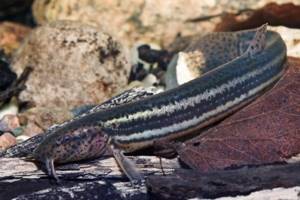
Area and description
These fish live in the rivers of Europe and Asia, as well as in Lake Baikal. They prefer bodies of water with a quiet current, prone to swamping, where there is a lot of algae, and there is a thick layer of silt at the bottom. These can be not only natural (rivers), but also artificial water bodies (ponds). They lead a benthic lifestyle with rare ascents to the surface. Loaches are extremely tenacious; they can stay in the moist mud of a drying up reservoir for quite a long time and thus wait out a temporary drought.
Photo gallery of Vyunov:
Lifestyle
Loaches are not fussy in their habitat; they live well even where there are no other fish at all. If it does not have enough oxygen, it will rise above the water and take in air, making a squeaking sound, which is why it is popularly called a squeak. Especially in summer you can hear the squeak of loaches.
Most of all, loaches prefer swampy, standing or slowly flowing waters. They love overgrown areas, channels and bays. This fish is striking in its strong sinuosity and long vitality. During drought, loaches burrow into the silt, so in such extreme conditions they are impossible to see with the human eye.
Loach fish habitats
For its residence, the loach has chosen the inland waters of the European continent, East and South Asia.
This fish is very unpretentious; it can often be seen in bodies of water where you will not find other fish. The loach likes wetlands, small, quiet rivers, creeks, and muddy lakes.
In such places this fish is quite comfortable, and it reproduces well. Loaches are not afraid of drought; they are able to survive even when water bodies dry out greatly.
In this case, the fish burrows into the silt two meters deep, calmly waiting until it rains and the reservoir is filled with water again.
It will not be possible to find loaches in fast-flowing mountain rivers; they are not found here.
A large number of loaches can be found in the rivers of the Moscow region, in swampy areas on the border with Belarus.
The peculiarity of this fish is that it can breathe not only through its gills, but also through its skin and intestines. Rising to the surface of the water, the loach captures air with its mouth and passes it through the intestines. As a result of these actions, a rather unusual sound appears, reminiscent of a squeak.
Loaches spend most of the day in a half-asleep, inactive state, hiding in the mud.
When darkness falls, they come to life and search for food.
Their food is small crustaceans, larvae, bloodworms, and worms.
Loaches love to feed on mosquito larvae and the eggs of other fish - carp, tench, crucian carp.
Since they are very voracious, there is a real danger for the reproduction of the listed fish; hordes of loaches actively clear water bodies of eggs.
In turn, loaches are a favorite delicacy for other, larger predators - pike, burbot, perch, and catfish.
For this reason, loach meat is an almost ideal bait for large predatory fish.
Up
Beneficial features
River loach in Russia is not considered a valuable fish, but the meat has high taste, because it is juicy, fatty and lacks small bones. In Asia, this fish is prized and considered a delicacy. Loaches are used as bait for catching pike, catfish and burbot. While on a hook, the loach is able to remain viable for 24 hours. The fish is useful for fighting mosquitoes, because the loach eats a large number of eggs, especially of mosquitoes.
Since loach meat smells like mud, fishermen often breed fish in clean ponds. To begin with, using ash, the fish is cleared of mucus, after which it is thoroughly washed under running water.
This fish is used to make fish soup; the frying method is used very rarely.
Loach dishes have many beneficial substances:
- Vitamin A. Ensures the health of mucous membranes, improves the process of production of sex hormones.
- Vitamin B. Increases the overall tone of the body and strengthens the immune system and heart muscle.
- Vitamin D. Promotes proper development of the skeleton and teeth.
- Fatty acids and amino acids. It has a beneficial effect on the cardiovascular system and normalizes the amount of cholesterol.
- Microelements. Magnesium, potassium, fluoride, zinc, potassium and iodine contribute to the proper functioning of the body as a whole.
Reproduction
Spawning of fish from the loach family lasts from April to June. The female has high fertility, because she can lay up to 38,000 eggs. The diameter of one egg reaches 1.9 mm and has a brown tint. A week later, the eggs hatch into 5 mm larvae, which adhere to the plants using special organs. Also in larvae, the respiratory function is performed by dense vessels in the pectoral fins.
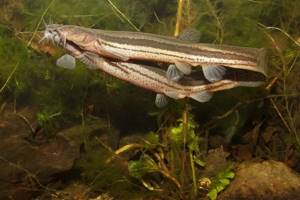
The fry develops and grows quite quickly, because in the first year of its life it grows up to 4 cm in length; at the age of three, their length already reaches 13 cm. Loaches are capable of reproducing after reaching the age of three. When the larva is 26 days old, its external gills disappear, and upon reaching 30 cm in length, it is considered a full-fledged fish, and not a fry.
Breeding and growing loaches
Some loaches have a rather exotic appearance, especially Asian fish. They began to import it from Asia to Russia back in the 19th century, since in those days it was fashionable to have at least one loach in your aquarium.
Although these fish get along with other inhabitants, it is still better to keep them separately, since they frighten other aquarium inhabitants with their active lifestyle.
Loaches are often purchased for further placement in reservoirs - this fish is capable of purifying water well. In winter, loaches bury themselves in silt and fall asleep for the whole winter, and only with the onset of warmth do they wake up and emerge. Loaches can be bred in reservoirs of any depth.
Even a small hole without frozen ice gathers loaches around itself, since they are in great need of oxygen. In this case, they can be caught simply with your hands, without any gear. Many fishermen breed loaches in small digs because they adapt to any conditions.
In Japan, loaches are raised and kept in separate aquariums to accurately predict changes in weather conditions and even natural disasters. Often these fish give a more accurate forecast than special weather stations.
How to catch a loach
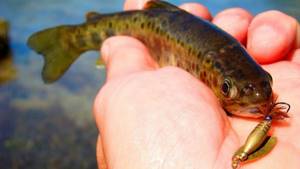
Float fishing for loaches
The best time for float fishing for loach in the middle climatic zone of Eurasia is from mid-spring to mid-autumn during the open water season. During this period, catching him on a hook is not particularly difficult.
For fishing you need a fly rod. This is a flexible pole 6 meters long, to the end of which equipment is attached. The thickness of the fishing line does not matter; the best option would be a monofilament of 0.2 mm; during floods it is better to take a diameter of 0.15 mm. A lightweight antenna float with a minimum load of one lead pellet, which will serve as a feeder, is ideal. The choice of hook will depend on the type of bait - for a worm No. 8-10, for bloodworms No. 16-18.
Before fishing for loaches, you must first prepare a fine-mesh container lowered into the water; Loaches jump out of the bucket and, wriggling, quickly hide in the grass and go back into the river. Thus, when you get carried away with new fishing, you can unwittingly get rid of already caught fish.
Fishing with Bolognese tackle
This type of gear is good for catching loaches on the river while fishing. A fishing rod with a length of at least 5 meters is equipped with a holder, an inertial reel and guide rings for monofilament fishing line with a diameter of 0.15-0.2 mm. The float must be loaded so that only half of the antenna is visible on the surface of the water. The bite usually occurs towards the end of the drive. When a loach grabs the bait, the float first rises, then goes either to the side or down under the water. When the float is under water, you need to hook it immediately, otherwise the loach will leave with the bait, leaving the angler with nothing.
Fishing in winter
Winter loach fishing involves the use of traps. The principle of the process is as follows. Since in winter the loach fish acutely senses the lack of oxygen in the water, it will instantly react to any supply of fresh water or air. You just need to know where they accumulate under the ice. In a swamp or shallow pond, it is enough to punch a hole in the ice crust and wait. In a few minutes, a flock of dozens of individuals can gather in it. This is what fishing with homemade traps is based on.
You need to take a medium-sized basket, box or sieve. The main thing is that there are side walls. The bottom of the vessel is covered with a tarpaulin and a hole is made in the middle into which a tube 10 cm long and with a diameter thicker than the body of the loach is inserted. The end of the tube is lowered 5 centimeters under the bottom of the trap. As the number of loaches in the device increases, it sinks deeper into the hole. During the fishing process, you need to make sure that the trap does not completely drown and that the water in the hole does not freeze. For insulation, straw is placed on top. Thus, loaches can be harvested all winter.
Loach fishing
Active piskun fishing can continue all year round, but the optimal time is considered to be from mid-spring to late autumn. The bottom lifestyle on soft soil seriously limits the arsenal of gear used. For catching loaches, a light fly rod with a blank length of 4-6 meters, equipped with:
- fishing line 0.2-0.25 mm;
- leash 0.14-0.18 mm;
- light float with 3-6 cm antenna;
- crochet number 8-18.
There are no special requirements for the fishing line. But it’s better if it matches the color of the water and is able to withstand snags on aquatic vegetation. The size of the hook is affected by the bait. If maggots, bloodworms, caddisfly larvae or bark beetles are used to catch bindweed, it is better to use small ones No. 16-18. No. 8-10 is suitable for mounting a worm.
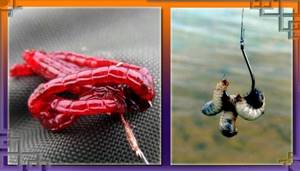
The bite is almost always confident and greedy. After a few tremors of the antenna and its slight shift to the side, you can perform a gentle hook. When the fish is hungry, the reaction of the float changes dramatically and becomes similar to the bite of a minnow or perch: the antenna dives sharply under the water.
Fishing for loaches from a boat is highly effective due to the ability to accurately catch the border of coastal vegetation, where small fish often feed and hide. On ice, winter float rods with attached bloodworms are used as gear.
When deciding what to feed a loach in a pond or aquarium, the same animal feeds that act as bait for fishing are used: bloodworms, earthworms and dung worms, maggots, caddis and bark beetle larvae. In addition, fish willingly eat pieces of raw meat cut into strips.
Aquarium loach
Loaches get along well with any other species of fish and feel great even in a small aquarium. The aquarium loach feeds on bloodworms, raw meat, worms and ant eggs. The fish collects food at the bottom of the aquarium with the help of its antennae, which are an organ of touch.
Loaches are careful about the vegetation in the aquarium; they do not spoil it or eat it. It is advisable to place several pieces of driftwood at the bottom to create a stone grotto. In addition, it is recommended to create a small dark area where the fish will feel calm, so that the conditions will be as close to natural as possible.
Since the fish is bottom-dwelling, feeding should be heavy, namely:
- worms;
- specialized dry food;
- herbal supplements;
- raw meat.
Nutrition
It feeds on insect larvae (especially chironomids), crustaceans, worms, small mollusks, as well as detritus and partially bottom vegetation. In captivity it can live without food for up to six months.
. In addition, the loach is known as an active eater of alien eggs. Hardly any inhabitant of rivers and lakes can compete with it in its ability to find it at the bottom. He does this so actively that in small bodies of water other fish often completely disappear. Crucian carp, carp, and tench suffer the most from loaches.

In an aquarium, the loach is voracious (as in the wild) and greedily grabs bloodworms, raw meat, earthworms, ant eggs, and picks up food only from the bottom. He finds food by touch (on his head around his mouth he has 10 antennae, which serve as the main organs of touch).
Loach fishing
Loaches are caught using dung or earthworms using float or bottom fishing rods. The diameter of the fishing line can be 0.15-0.25 mm, and the hooks are number 5. The nozzle must be lowered to the very bottom, and there is no need to be afraid that if it gets into the silt, the loach will not find it. On the contrary, it finds food easier and faster at the very bottom than at the top. Loaches are unpretentious and can even bite on an empty hook without bait.
Fishermen rarely catch loaches for food; they mainly become prey for catching other fish species, but for many areas this is prohibited by Russian law. In order not to become a violator of the rules established by the state, it is recommended to study this issue in advance regarding the area where you will be fishing.
The caught fish must be held firmly with both hands, it wriggles very much and besides, the fish is slippery.
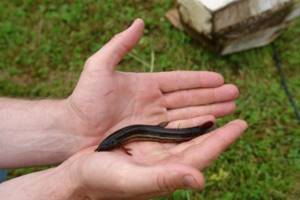
Lifestyle of a loach
The loach is a resident of muddy and swampy bodies of water. Prefers streams, quiet river backwaters, muddy ponds, and channels. Does not like rivers with intense currents. It can easily cross small areas of land from lake to river and the like, moving like a snake and relying on its ventral front fins. The loach fish easily survives prolonged droughts, burrowing into wet mud.
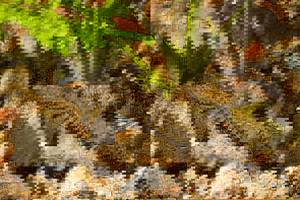
Antennae help the loach search for food
The loach feeds on mollusks, insects, and worms. It even eats silt, saturated with microorganisms and various larvae.
Natural enemies of loaches
Loach is a resourceful, tenacious fish. She doesn't have many natural enemies. This is also due to its habitat. As a rule, loaches prefer to live in swampy bodies of water, where there are no other fish or only a small number of them live. However, there are still animals that eat loaches for food. The most dangerous natural enemies of loaches are predatory fish. Loach is an important part of the diet of burbot, pike and perch.
Of course, catching a loach is not easy even for predatory fish. Loaches can quickly hide from danger and burrow very deep into the silt. But sometimes even this does not help to get away from the predator. Loaches are also often attacked by birds. Loaches become prey for birds when they try to move to a neighboring body of water on wet grass. Some birds manage to get this fish right from the bottom of a half-dried pond or swamp. It is extremely rare for a loach on land to become prey for other predatory animals that happen to be nearby.
Humans can also be called an enemy of snake-like fish. The loach doesn't look very attractive. Many fishermen, having accidentally caught such a fish, simply throw it ashore. Other fishing enthusiasts specifically catch large quantities of loaches and then use them as bait.
Interesting Facts
There are some interesting facts about the loach fish:
- Fish can remain alive and viable without food for 5 months.
- The loach can be without water for a long time. Unlike other fish, the loach is able to breathe both through its gills and through its skin and intestines. The intestinal walls are equipped with blood vessels; they perform their function when there is not enough oxygen.
- Large loaches can crawl from one body of water to another; this happens in the morning when there is dew.
- Loaches always predicted the weather. 24 hours before a thunderstorm, fish float up and rush back and forth, greedily swallowing air. Based on these signs, fishermen understand that it will rain in a day. They rush about because they sense a change in the weather.
The loach is unpretentious in maintenance, very hardy and long-lived. These fish can even live without water for about a day, and without food for six months. Loaches are rarely eaten because of their specific smell; they are mainly used as bait for other fish. Interestingly, the loach accurately predicts changes in weather conditions and the onset of natural disasters.
0
0
Copy link
